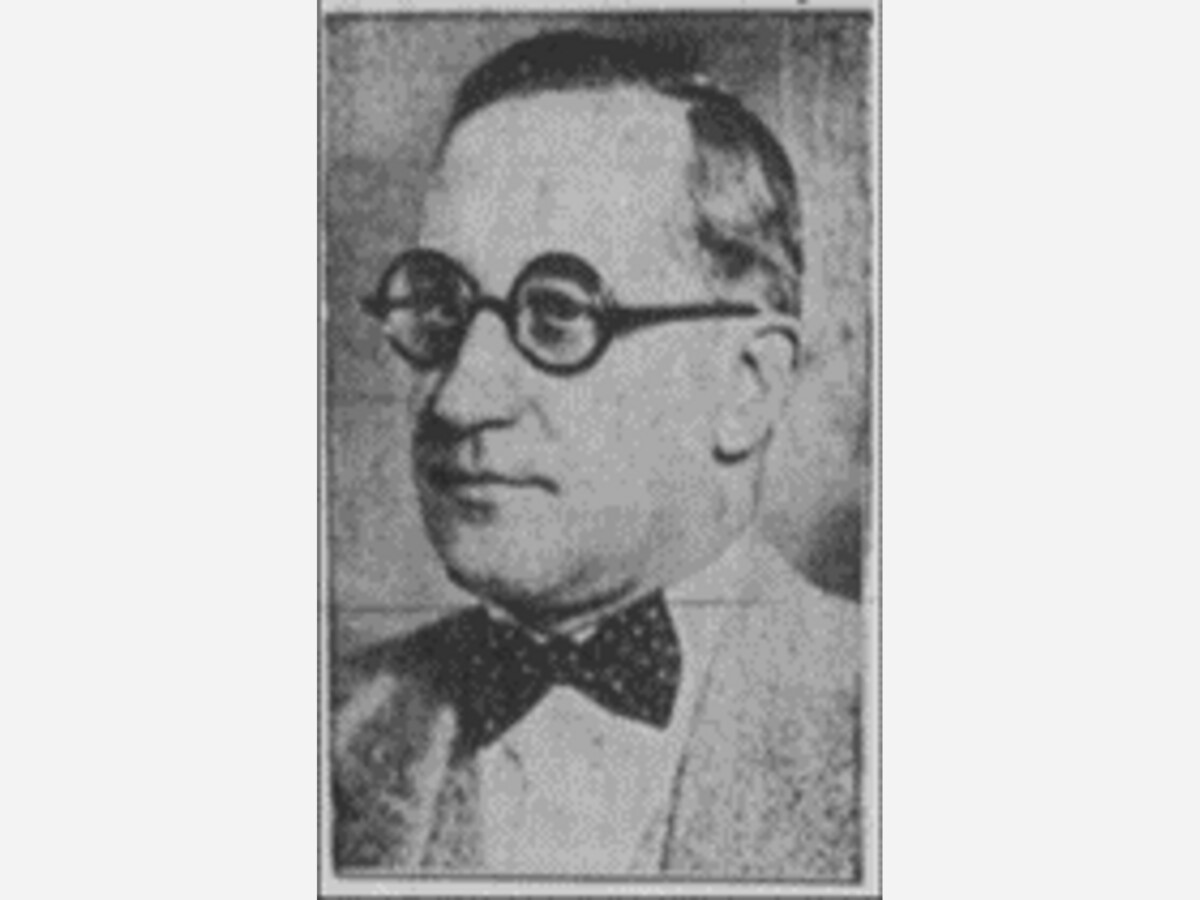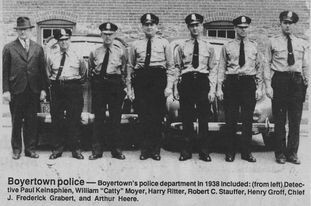Image


by Betty J. Burdan*
Who knew that Boyertown had its own Sherlock Holmes or at least a Holmes-like detective? He did not wear a tweed deerstalker hat, gentleman’s cape nor smoke a clay briar pipe. His signature attire was a simple suit, a bow tie and horn-rimmed glasses. His smoke of choice was cigars, of which he enjoyed 6 or 8 a day.
His name was Paul Kleinspehn (pronounced Kline-spain). He was appointed Boyertown’s Police Chief in 1933, serving in that capacity for nearly 10 years. He worked in plain clothes and drove his own personal vehicle. Dubbed the “plain clothes man” by Burgess H. Leon Breidenbach, he became well known throughout Berks and surrounding areas.
Born in West Reading in 1889, he was the son of John and Mary (nee Gehret) Kleinspehn. At age 15 he took an interest in bowling, becoming the Amateur Champ of Reading, bowling a perfect game in 1909. His first job was as a newspaper man in Kutztown. His keen and inquiring mind lead him to Washington, DC during WWI where he was employed by the government. He later attended the Pennsylvania State Police School along with Boyertown’s Arthur Heere, who may have been the one who introduced Boyertown to Kleinspehn.
Dedicated to keeping the peace, in 1923 he found himself singlehanded in a gun battle with a group of desperados fleeing from an express wagon robbery in Reading. As he attempted to block the escaping bandits car, they opened fire as he pulled in front of them. He responded firing his own weapon, shattering the window in their car and capturing the thieves.
In 1925 he began his career as a private detective, heading the Merryfield agency in Pottstown. Three years later he came to Boyertown, going into business for himself as a licensed detective at 127 East Philadelphia Avenue. Immediately on his agenda was a $1500 robbery of Raymond K. Mensche’s car dealership in Gilbertsville, which he solved.
His successes were many and he became known as the man with the “Camera eye.” He had a talent for remembering names, faces and details of every incident and crime. When a difficult case arose anywhere the cry went out to “send for Kleinspehn.”
In 1927 a man named Pascucci came to Kleinspehn’s attention when he threatened to kill a Gilbertsville constable. Two years later Kleinspehn spotted him in a crowded courtroom in Norristown and arrested him.
In 1928 he exchanged gunfire with 3 baggage car robbers at the Boyertown station. He soon caught 2 of them on the spot and the third 5 years later.
In 1931 a trickster broke out of the Boyertown jail taking the lock with him. Within a few days Kleinspehn captured the escapee and returned him to the lockup.
The swindle of George Unger, retired manufacturer of Boyertown, amounting to $14,500 sent Kleinspehn on a manhunt that took him all the way to California to extradite one of the perpetrators. Unfortunately, the culprit skipped out on his bail and was in the wind by the time Kleinspehn got there. The trip was not uneventful however as the train Kleinspehn was returning on derailed near Las Vegas.
In 1933, when Boyertown’s Chief of Police Henry Gruber passed away, Kleinspehn was appointed chief. The 10 years he held the position was a bad decade for the no-goods, intent on robbing and otherwise doing harm to locals.

Ahead of his time, he conducted a sting operation to capture 3 Philadelphia suspects. They had committed a serious of robberies taking more than $25,000 (nearly $500,000 today) in all from area clubs. An offer, they apparently couldn’t refuse, was made in an invitation sent to the them to come to Boyertown to join the Orioles. They came and were arrested and sent to jail.
In 1934, taking it personally when a robber broke a hickory club over his head, Kleinspehn responded by pulling his own weapon, apprehending and escorting the culprit to jail.
The Boyertown Halloween parade always drew large crowds and proved an attractive target for pick-pockets. Kleinspehn solved that problem by hiring up to 40 special police to mingle in the crowd, keeping an eye out for offenders. They lowered the rate to 0.
By 1935, thanks to Kleinspehn who had become a fingerprint expert, Boyertown had one of the first complete fingerprinting systems and Rogues Galleries in the area. Criminals began to ignore Boyertown, fearing Kleinspehn and the sawed-off shot gun, high powered rifle and hand gun he was known to carry. There was a 20 month period in 1937 and 1938 when Boyertown experienced no crime at all. He arrested well over 2000 criminals and claimed only 2 acquittals.
He became an assistant Berks County Detective in 1940 and Chief of Berks County Detectives in 1943. He left the Boyertown department at that time but remained a resident of Boyertown at 400 East Philadelphia until his death in 1966. He is buried at Fairview Cemetery.
Kleinspehn was an excellent detective keenly interested in new approaches. He continued to learn, taking courses and doing laboratory work during his entire career. He felt working cooperatively with other departments and involving the community were vital to fighting crime. He was a credit to the Boyertown department and CSI would have been happy to have him.
* Betty J. Burdan, historian extraordinaire, writes for pleasure, shares with other publications. Climbed the family tree in 1990 and got hooked on local history Has a special interest in WWII and local veterans. Willing to share.